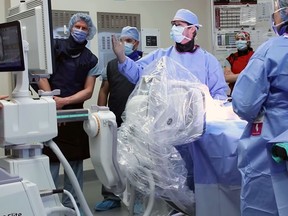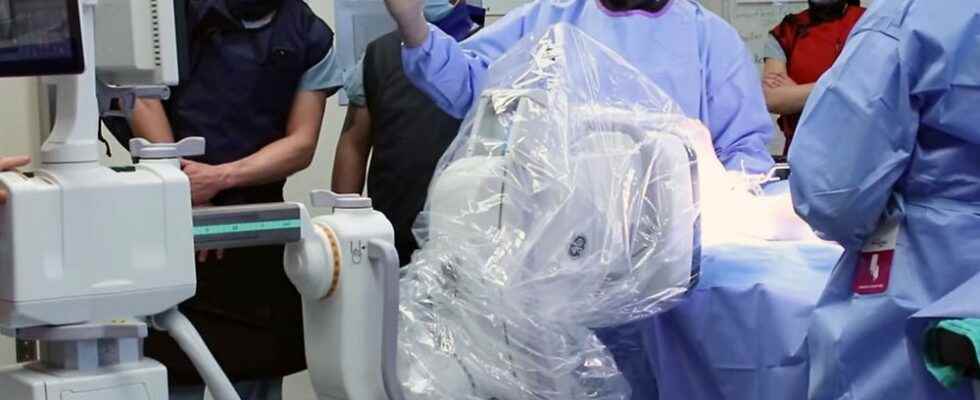Physicians and staff at Chatham-Kent Health Alliance performed their first two ankle replacement surgeries, bringing a new service to local hospitals.

Physicians and staff at Chatham-Kent’s hospital group have performed their first two ankle replacement surgeries, bringing a new service to local hospitals.
Rick Houston, a retired police officer, was the first recipient on Feb. 25. Another procedure was completed about three weeks later.
Dr. Hans Hundt, who performed both surgeries, said he began looking into offering the procedure about a year ago. When he started working with the health alliance a decade ago, ankle fusion was the preferred type of surgery for ankle arthritis, he said.
“They (replacements) were quite costly – almost cost prohibitive – for our community hospital to be doing that kind of thing 10 years ago,” said Hundt, adding he had no plans at the time to start an ankle replacement service.
A replacement ankle also used to last five to seven years, compared to 25 to 30 years for a replacement hip or knee, he said.
As he attended more conferences over the years, he said he started to see the technology improve to the point where ankle replacements and ankle fusion were “fairly equivalent in outcome” to one another.
“It was becoming more evident in my own practice that it was no longer reasonable not to offer the ankle replacement to the appropriate patient population, and only be able to offer ankle fusion,” Hundt said.
The surgeon said he was referring about eight to 12 patients per year to doctors in Toronto. However, some found there was a three-year wait to have the surgery, so they ended up requesting an ankle fusion instead.
“That’s a shame when you have to do something that’s not as good as an option for a patient just because they can’t gain access to the better option,” he said.
Last year, Hundt found out the cost of the implant was about 50 per cent less than in 2012. The implants are made of cobalt chrome and stainless steel, with a polyethylene liner, the same material used for hip and knee replacements.
He presented a business plan to the health alliance, outlining how the hospital sites were offering other orthopedic implants at equal cost.
Hundt went to the Canadian Surgical Technology & Advanced Robotics lab at University Hospital in London to train for the procedure last year.
The lab brought in Dr. Murray Penner, a surgeon from Vancouver who has performed “thousands” of these procedures, Hundt said. Penner demonstrated the surgery on a cadaver before Hundt performed it on one himself.
Dr. David Stevens, a Kitchener-Waterloo surgeon who has been performing ankle replacements for over 10 years, assisted Hundt on the first local surgery in February.
“That gave me confidence. After that, he (Stevens) agreed it went really well,” Hundt said.
Along with Hundt, the procedure requires an anesthetist, a circulating nurse, a scrub nurse, either another physician or a registered nurse trained in assisting, and an X-ray technician.
“This procedure requires the aid of interoperative X-ray to ensure you’re putting the implant in the appropriate alignment,” Hundt said. “It’s a multi-disciplinary approach and there is lots of support available during the procedure.”
Afterwards, nurses on the floor and physiotherapists help the patient recover.
“So many different individuals are involved when we try to introduce a new service,” Lori Marshall, president and CEO of the health alliance, said. “I really want to extend my thanks and congratulations to everyone who has been involved in this, really broadening the exceptional service that we’re able to provide.”
Hundt said the procedure takes less than two hours to complete, which is “at least” twice as long as a knee or hip replacement. He said technological advances may eliminate the need for X-rays during the procedure, but that would be an additional cost to the hospital.
In a video released by the health alliance, Kate Martin, a registered nurse who worked in the operating room for the first surgery, said teamwork was critical during the procedure.
“We had (industry) reps come in that helped us. We also had Dr. Hundt, who taught us everything we needed to know, as well as the surgeon who came in and assisted,” she said, “but everyone worked as a team and I think it made the procedure go smoother.”
Houston said he was trying to enjoy his retirement by walking nine or 10 kilometers a day and attending aqua fitness.
“About three years ago, my ankle really started bothering me,” he said in the video. “It got progressively worse over that period of time. I was getting shots. I was seeing various doctors. Nobody was giving me a solution.”
Eventually, Houston’s rheumatologist suggested he see an orthopedic surgeon.
He said he plans on walking trails in places like Point Pelee National Park and Rondeau Provincial Park once he’s fully recovered.
Patients currently stay overnight following the surgery, though Hundt said some of the surgeons who trained him to send their patients home the same day.
The doctor said he expects to perform up to 12 of these surgeries per year to start.
“The incidence of severe ankle arthritis in a population is significantly less than knee and hip arthritis, but for those patients who have it, it can be just as disabling as a knee or a hip arthritis,” he said.
“We have the treatment available and it’s important to offer that to people.”
